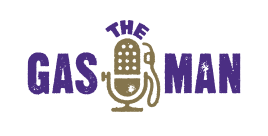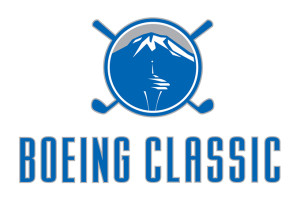
In 2015, I worked as a media consultant and content creator for the Boeing Classic golf tournament. I’ve always been a big fan of the tournament and its long-term commitment to help fund the work of two great Seattle organizations: The Benaroya Research Institute at Virginia Mason (BRI), and The First Tee Seattle.
One of the things I wanted to do was explore the money trail and find out what is being done with money raised by ticket purchases to the Boeing Classic. Where does that money go and who benefits? I found out that the money goes to help hundreds of people do ongoing work at both BRI and The First Tee. This work benefits anyone who has or knows someone with an autoimmune disease and anyone who’s interested in helping kids who might not have easy access to golf get a chance to learn the game.
During the week of the tournament, I worked with print, electronic, and digital media outlets on story placement. Our Twitter campaign created over 125,000 impressions in three days. Below are four short examples from these efforts showing how money from your ticket purchase to the Boeing Classic helps continue and further great work. These four people are working examples of how professional sports benefit our community.


Boeing Classic Proceeds at Work for Benaroya Research Institute and First Tee Seattle
By Mike Gastineau
Imagine you are looking at a container filled with a million golf balls. All but 25 are the same brand. Your job: find the balls with a different brand name and remove them. Now, think how much easier your task would be if the 25 balls you needed to remove were colored red instead of white. You’d be done with the search in a fraction of the time it would take if all the balls were white.
This, in a sense, is what doctors and scientists at the Benaroya Research Institute at Virginia Mason (BRI) are doing in their efforts to study and find cures for autoimmune diseases. Autoimmune diseases strike one in 20 Americans. Among the more notorious: type 1 diabetes, chron’s and colitis, MS, lupus, and rheumatoid arthritis. All autoimmune diseases have one basic commonality: the T cells that make up the immune system and help fight off diseases make a mistake and begin attacking the body.
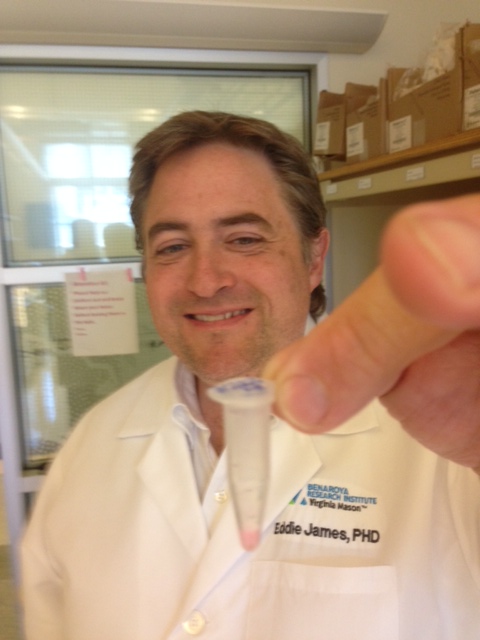
BRI research scientist Dr. Eddie James with a vial of Class II Tetramers
“We study T cells,” says Dr. Eddie James. “They’re really important. I call them the roving security guards of the immune system. They patrol your body looking for troublemakers. And if they find them they pull the alarm and they call in the big guns, the cells that do the killing.”
But some T cells don’t recognize the difference between what doctors call “self” (things in the body naturally that are helping us to live) and “non-self” (bad stuff that needs to be removed). The body kills most of these confused T cells but some survive and instead of looking for troublemakers become troublemakers themselves. The goal at BRI is to find out why these rogue T cells exist and find a way to eradicate them.
That job was made easier in 1996 when Drs. Gerald Nepom and William Kwok invented Class II Tetramers at BRI. A tetramer is a man-made mimic of a human protein. Once introduced into a blood sample, the tetramers attach themselves to bad T cells and emit a red florescent light. This allows researchers to find bad cells in a short amount of time.
“There are a million cells in one drop of blood,” James says. “Before tetramers if you wanted to do experiments to measure the behavior of someone’s T cells you had to look at all of them. But if there’s a million in there, and only 25 are auto reactive, anything you’re measuring is mainly the irrelevant cells. What this enables us to do is mark just the T cells we’re interested in. We’re seeing things that we just couldn’t see before.”
BRI is home to the world’s supply of tetramers. “It looks like a laboratory,” according to James, “but it’s also a factory.” The more researchers looking at bad T cells using tetramers, the higher the likelihood of a cure. So BRI manufactures and ships tetramers at cost and for no profit to any researcher who needs them.
When you attend the Boeing Classic, part of your ticket price goes to BRI with over $2 million donated to date to help over 275 scientists, researchers and staff continue the fight against autoimmune diseases.
“We’re at the nexus of all of this,” says James. “We have technologies, patient registries and sample repositories, and clinical trials and our goal is to bring it all together. We don’t want to just write papers. We want to make people better.”
By Mike Gastineau
Would you enjoy a golf tournament with no scoreboard and no organized scoring system? Imagine trying to figure out was happening on the course if you had no centralized place to get updated on how each golfer was doing. It would obviously be time wasting and frustrating.
Fortunately for golf fans there are scoreboards and systems in place to allow for the easy sharing of information. Details are compiled at a central location and quickly disseminated so that a fan watching action on the 4th hole is easily able know what just happened on the 16th hole and how that affects the tournament.

Dr. Jared Odegard diagrams the BRI’s information sharing systems.
In some ways, Dr. Jared Odegard and the team of research scientists at Benaroya Research Institute at Virginia Mason (BRI) are running a giant scoreboard and information center in the fight against type 1 diabetes and dozens of other autoimmune diseases. Through programs developed at BRI they’ve created a way for researchers around the world to share information on patients and small clinical trials testing new treatments that can lead to widespread gains in the effort to cure millions of people affected by these diseases.
Much of the work done at BRI starts with volunteers who donate personal information and blood samples for research. This information is BRI’s registries and biorepositories that aid researchers studying the diseases all over the world.
“We couldn’t learn everything about diabetes on our own,” Odegard says. “It’s a collaborative effort. We’re the people leading the charge to keep everyone together and moving in the same direction.” Type 1 Diabetes TrialNet, led by BRI, is an international network dedicated to finding ways to prevent, delay and slow progression of the disease. TrialNet allows researchers working on cures for type 1 diabetes to share information on clinical trials. “When researchers around the country have a new idea, it’s run through TrialNet,” Odegard says. “The network evaluates scientifically and feasibility of the idea.”
“In small trials,” Odegard says, “we take new ideas and evaluate them. It might be giving 10 people a new drug; such as a drug used in rheumatoid arthritis to see if it affects the immune system in diabetes. We’re learning which ones work and which ones don’t. We’re making tremendous progress in a very real sense. We know we can modify this disease.”
Every day progress is being made, and because of these networks of information-sharing centered at BRI, researchers in Seattle are connected and collaborating with researchers worldwide. Odegard agrees that when a cure for type 1 diabetes is found the scientists, doctors, and researchers at BRI will have their fingerprints all over it.
“Absolutely. There’s no question. It’s very exciting. It’s cool. The leading edge of type 1 diabetes clinical research is right here.”
By Mike Gastineau
Like all of us, golfers benefit from advanced technology. Equipment, course mapping, and better medical treatment for injuries are all dramatically improved. The game is still the same, but players today benefit from things not imagined 50 years ago.
The same goes for people who suffer from type 1 diabetes, and there’s no better example of that than Annie Shultz. Her father was diagnosed with the disease in 1964 and after a series of complications died at the age of 58. When Shultz was diagnosed as type 1 at the age of 21 she realized that she had some advantages that weren’t available to her father.
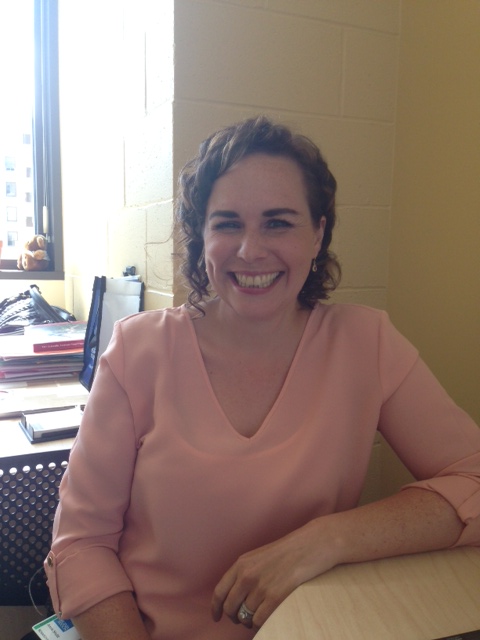
Annie Shultz, Project Manager for Outreach and Recruitment for Diabetes TrialNet at BRI
“When my father was diagnosed he had a needle that he screwed on to a glass vial,” she says. “He sharpened it with a pumice stone. It sounds very Fred Flintstone but that was the method of delivery then. The insulin he was using was from a pig or a cow. It didn’t mimic pancreatic function the way the insulin I use today–synthetic insulin does. Glucometers didn’t exist when he was diagnosed, so he had no idea what his blood sugar was.”
Shultz monitors her blood sugar with a continuous glucose monitor, blood glucose meter and wears an insulin pump. But due in part to research being conducted at Benaroya Research Institute at Virginia Mason (BRI) she may someday be free to live without constant monitoring of those devices thanks to the invention of the artificial pancreas.
“The artificial pancreas system uses existing technologies including an insulin pump and a continuous glucose monitor,” Shultz says. “The component that is being tested is the brains of the system—an algorithm that allows the two technologies to talk to each other. The continuous glucose monitor transmits information to the algorithm. The algorithm then tells the glucose pump to deliver insulin. A lot. A little. Stop. It does this every 5 minutes.”
The technology was invented by two Boeing engineers and a local pediatric endocrinologist. It uses “fuzzy logic”, the technology that allows an autopilot to fly a plane. Various artificial pancreas systems are being tested through trials right now at a handful of research institutions around the world including BRI.
“It’s life changing technology. The invention of insulin and the commercialization and implementation of patients using insulin changed the face of type 1 diabetes. The invention of the artificial pancreas will be equivalent to that. It will change the lives of people with type I diabetes. You’re always thinking about how things are impacting your blood sugar. The artificial pancreas removes those concerns from you.”
Can one ticket purchased for one golf tournament make a difference in medical research? Shultz answers the question unequivocally.
“The artificial pancreas study that I was a part of started with a $50,000 dollar grant. Last year BRI received $800,000 dollars from the Boeing Classic. People think medical research is expensive and it is but it has to start somewhere. Yes, your money is absolutely impactful. Here’s this incredible technology that was started with a $50,000 dollar grant.”
Shultz not only has benefitted from the research as a participant in trials for the artificial pancreas, she helps others, too, since she works at BRI as the Project Manager for Outreach and Recruitment for Diabetes TrialNet, the leading network for type 1 diabetes prevention research. She sees the work being done (and how it helps people like her) first hand.
“Being able to see the incremental breakthroughs that change the path of research…those breakthroughs happen at BRI and that impacts research around the world. Something discovered here changes research worldwide. You hear about breakthroughs happening here and it’s pretty tremendous.”
 By Mike Gastineau
By Mike Gastineau
Visit a golf practice session at The First Tee and prepare to be humbled. You’ll see kids hitting the ball long and straight with smooth effortless swings. But the golf isn’t the only thing that impresses.
“We’re always hoping they’ll learn a lot more,” says The First Tee of Greater Seattle Event and Volunteer Director Shelby Lanting. “They’re learning how to meet someone, how to shake their hand, how to look them in the eye. It’s the whole gamut of interpersonal skills, goal setting, and what responsibility looks like.”
Hang around long enough and you’ll see that’s true. Young golfers will, one by one, make their way over to introduce themselves in a confident, self assured manner that belies their youth.
Lanting is part of a staff of four full time workers and almost 40 part time coaches. The coaches have assistants, often times people who were involved in the program as kids, are now in college, and assist with teaching during the summer.
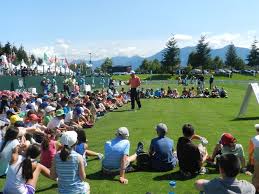
Kids from The First Tee Seattle attend a clinic at the Boeing Classic.
She says they try to keep the student to teacher ratio as low as possible to create as much personalized mentoring as possible. That’s a huge task for a program that impacts 1700 kids between the ages of five and 18 in King County each summer at Jefferson, Jackson, Crossroads, River Bend and Willow’s Run golf courses. Another 75,000 young people are impacted during the school year by classes done in conjunction with Phys Ed instructors.The First Tee coaches don’t just show up and start teaching. Lanting says even those who want to teach and know the game have to learn The First Tee way of doing things.
“We send our coaches all around the nation to be able to get trained by the best First Tee trainers so they’re teaching The First Tee philosophy and not just how to swing a club.”
That philosophy encourages kids to use golf as a method of developing life skills. And part of that is allowing young golfers to figure some stuff out on their own.
“We might show them how to hold the club,” Lanting says, “but if they do it differently, use a different grip, we don’t jump in and say ‘you have to do it this way.’ They’ll see from other kids in the program that if you hold it a certain way the ball flies a little bit better.”
Money from the Boeing Classic helps The First Tee handle the financial end of the program.
“It costs us $500 to put a kid through the program for one year. We only charge them $99. A third of our students are subsidized. So donations are used to pay for kids, get them into classes, and pay for their coaches, golf course time. We offer college scholarships to older kids in the program.”
The First Tee of Greater Seattle is also planning a clubhouse at Jefferson Golf Course where kids will have a place to hang out and learn more about how golf and life intersect. That project is chaired by Fred Couples and the new building will bear the name of the Seattle great who learned the game as a kid at Jefferson. “He knows the importance,” Lanting says, “of having space at Jefferson.” She then sums up the importance of The First Tee and their mission.
“We’re continually working to make sure these kids have a place to play.”
